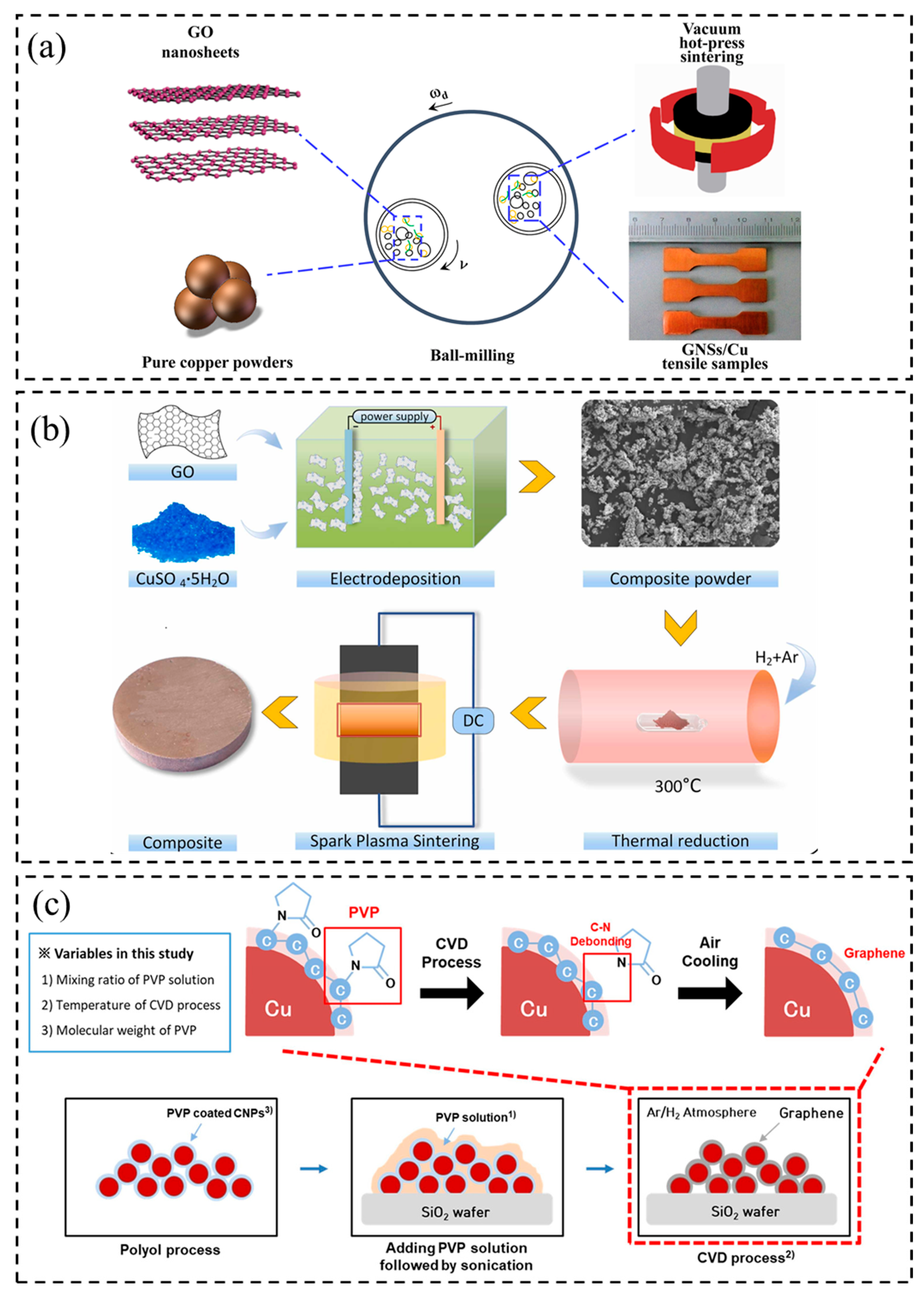Research Progress on the Preparation and Properties of Graphene–Copper Composites
Abstract
1. Introduction
2. Preparation of CGCs
3. Research Progress on Electrical Conductivity
3.1. Theory of Conductive Mechanism
3.2. Structural Design Innovation
3.3. Optimization of Preparation Process
4. Research Progress on Thermal Conductivity
4.1. Theory of Heat Conduction Mechanism
4.2. Structural Design Innovation
4.3. Optimization of Preparation Process
5. Research Progress on Mechanical Properties
5.1. Mechanical Mechanism Theory
5.2. Structural Design Innovation
5.3. Optimization of Preparation Process
6. Interface Engineering: Decoupling the Strength–Conductivity Trade-Off
7. Summary and Prospects
- (1)
- Atomic-level interface engineering. While current studies often correlate processing parameters with macroscopic properties, a deeper understanding of atomic-scale interfacial phenomena remains essential. Fundamental mechanisms governing charge transfer, chemical bonding states, and defect-mediated adhesion at the graphene–copper interface need further elucidation. Given the high reactivity of metallic copper, precise control of interfacial reactions is crucial—not only to prevent the formation of resistive phases but also to exploit potential synergistic effects. Such knowledge is imperative for the rational design of composites with predictable and tailored properties.
- (2)
- Spatial organization of graphene. Realizing the full potential of CGCs depends critically on achieving uniform graphene dispersion and controlled alignment within the copper matrix. Although surface modification strategies can improve wettability, the underlying principles governing nanoscale distribution and orientation require systematic investigation. Advanced processing techniques that enable the directional alignment of two-dimensional graphene sheets could yield composites with designed anisotropic characteristics, opening up applications in directional heat management and structured load-bearing components.
- (3)
- Architectural design of composites. Current composite systems primarily utilize graphene as a discrete reinforcing phase. Future designs should pursue more sophisticated architectures, such as metal-decorated graphene interfaces or graphene-encapsulated metal particles, to construct hierarchical and multifunctional material systems. These novel configurations could significantly broaden the application horizons of CGCs into fields including catalytic systems, energy storage devices, and advanced electronic packaging.
Author Contributions
Funding
Data Availability Statement
Conflicts of Interest
Abbreviations
| Gr | Graphene |
| CGCs | Graphene–copper composites |
| Cu | Copper |
| IACS | International Annealed Copper Standard |
| APCVD | Atmospheric pressure chemical vapor deposition |
| CVD | Chemical vapor deposition |
| SPS | Spark plasma sintering |
| HP | Hot-press |
| RTA | Rapid thermal annealing |
| PM | Powder metallurgy |
| MLM | Molecular-level mixing |
| RGO | Reduced graphene oxide |
| GO | Graphene oxide |
| 2D | Two-dimensional |
| 3D | Three-dimensional |
| PECVD | Plasma-enhanced chemical vapor deposition |
| CNs | Carbon nanostructures |
| VGr | Volume fraction of graphene |
| GN | Graphene network |
| ITR | Interfacial thermal resistance |
| UTS | Ultimate tensile strength |
| HEB | High-energy ball milling |
References
- Yu, Y.; Feng, S.; Liu, Y.; Yan, Z.; Chen, G.; Yang, J.; Zhang, W. Effect of Temperature on the Mechanical Properties, Conductivity, and Microstructure of Multi-layer Graphene/Copper Composites Fabricated by Extrusion. J. Mater. Eng. Perform. 2025, 34, 7773–7785. [Google Scholar] [CrossRef]
- Gao, J.; Jiang, S.; Zhang, H.; Huang, Y.; Guan, D.; Xu, Y.; Guan, S.; Bendersky, L.A.; Davydov, A.V.; Wu, Y.; et al. Facile route to bulk ultrafine-grain steels for high strength and ductility. Nature 2021, 590, 262–267. [Google Scholar] [CrossRef]
- Zhao, C.; Zhang, Z.; Wang, Y.; Zhao, M.; Sun, W.; Liu, Q.; Ding, M.; Wang, J.; Cheng, Q.; Fu, Y.; et al. Robust integrity of graphene in heavily stretched copper composites. Nano Res. 2025, 18, 94907485. [Google Scholar] [CrossRef]
- Gao, S.; Wang, Q.; Guo, H.; Liu, X.; Li, G.; Dong, L.; Song, K. High strength and high electrical conductivity Cu composites reinforced by SiO2 aerogel particles. J. Mater. Res. Technol. 2023, 24, 2346–2356. [Google Scholar] [CrossRef]
- Tomita, M.; Suzuki, K.; Fukumoto, Y.; Ishihara, A.; Akasaka, T.; Kobayashi, Y. Energy-saving railway systems based on superconducting power transmission. Energy 2017, 122, 579–587. [Google Scholar] [CrossRef]
- Zhang, W.; Zhang, P.; Lu, D.; Pan, H.; Liu, X.; Xu, C.; Wei, J.; Li, M.; Ji, H. A supersaturated Cu-Ag nanoalloy joint with ultrahigh shear strength and ultrafine nanoprecipitates for power electronic packaging. J. Mater. Sci. Nanotechnol. 2023, 145, 56–65. [Google Scholar] [CrossRef]
- Lu, L.; Shen, Y.; Chen, X.; Qian, L.; Lu, K. Ultrahigh Strength and High Electrical Conductivity in Copper. Science 2004, 304, 422–426. [Google Scholar] [CrossRef]
- Shimokawa, T.; Niiyama, T.; Miyaki, T.; Ikeda, M.; Higashida, K. A novel work hardening mechanism of nanoscale materials by grain boundary transformation. Acta Mater. 2022, 224, 117536. [Google Scholar] [CrossRef]
- Liu, Y.; Zhang, J.; Niu, R.; Bayat, M.; Zhou, Y.; Yin, Y.; Tan, Q.; Liu, S.; Hattel, J.H.; Li, M.; et al. Manufacturing of high strength and high conductivity copper with laser powder bed fusion. Nat. Commun. 2024, 15, 1283. [Google Scholar] [CrossRef]
- Hidalgo-Manrique, P.; Lei, X.; Xu, R.; Zhou, M.; Kinloch, I.A.; Young, R.J. Copper/graphene composites: A review. J. Mater. Sci. 2019, 54, 12236–12289. [Google Scholar] [CrossRef]
- Wang, Y.; Chen, M.; Zhou, F.; Ma, E. High tensile ductility in a nanostructured metal. Nature 2002, 419, 912–915. [Google Scholar] [CrossRef]
- Geng, Y.; Zhang, X.; Zheng, Y.; Zhao, L.; Li, Z.; Li, X.; Qi, R.; Wang, Z.; Sha, G.; Zhang, D.; et al. High strength and plasticity in disordered multilayer graphene reinforced copper composites. Nat. Commun. 2025, 16, 6804. [Google Scholar] [CrossRef] [PubMed]
- Lee, C.; Wei, X.; Kysar, J.W.; Hone, J. Measurement of the Elastic Properties and Intrinsic Strength of Monolayer Graphene. Science 2008, 321, 385–388. [Google Scholar] [CrossRef] [PubMed]
- Kashani, H.; Kim, C.; Rudolf, C.; Perkins, F.; Cleveland, E.; Kang, W. An Axially Continuous Graphene–Copper Wire for High-Power Transmission: Thermoelectrical Characterization and Mechanisms. Adv. Mater. 2021, 33, 2104208. [Google Scholar] [CrossRef] [PubMed]
- Chu, K.; Jia, C. Enhanced strength in bulk graphene–copper composites. Phys. Status Solidi A 2014, 211, 184–190. [Google Scholar] [CrossRef]
- Cao, H.; Tan, Z.; Lu, M.-H.; Ji, G.; Yan, X.-J.; Di, C.; Yuan, M.; Guo, Q.; Su, Y.; Addad, A.; et al. Graphene interlayer for enhanced interface thermal conductance in metal matrix composites: An approach beyond surface metallization and matrix alloying. Carbon 2019, 150, 60–68. [Google Scholar] [CrossRef]
- Cheng, Z.; Bu, L.; Zhang, Y.; Wu, H.; Zhu, T.; Lu, L. Characterization of gradient plastic deformation in gradient nanotwinned Cu. Acta Mater. 2023, 246, 118673. [Google Scholar] [CrossRef]
- Chen, B.; Zeng, X.; Liu, Z.; Dong, W.; Pei, D.; Wang, H.; Dong, Y.; Wu, C.; Gao, X.; Xiao, H.; et al. Edge-feeding synchronous epitaxy of layer-controlled graphene films on heterogeneous catalytic substrates. Nat. Commun. 2025, 16, 5490. [Google Scholar] [CrossRef]
- Mehta, R.; Chugh, S.; Chen, Z. Enhanced Electrical and Thermal Conduction in Graphene-Encapsulated Copper Nanowires. Nano Lett. 2015, 15, 2024–2030. [Google Scholar] [CrossRef]
- Wang, L.; Yang, Z.; Cui, Y.; Wei, B.; Xu, S.; Sheng, J.; Wang, M.; Zhu, Y.; Fei, W. Graphene-copper composite with micro-layered grains and ultrahigh strength. Sci. Rep. 2017, 7, 41896. [Google Scholar] [CrossRef]
- Guermoune, A.; Chari, T.; Popescu, F.; Sabri, S.S.; Guillemette, J.; Skulason, H.S.; Szkopek, T.; Siaj, M. Chemical vapor deposition synthesis of graphene on copper with methanol, ethanol, and propanol precursors. Carbon 2011, 49, 4204–4210. [Google Scholar] [CrossRef]
- Guo, S.; Zhang, X.; Shi, C.; Liu, E.; He, C.; He, F.; Zhao, N. Enhanced mechanical properties and electrical conductivity of graphene nanoplatelets/Cu composites by in situ formation of Mo2C nanoparticles. Mater. Sci. Eng. A 2019, 766, 138365. [Google Scholar] [CrossRef]
- Shu, S.; Yuan, Q.; Dai, W.; Wu, M.; Dai, D.; Yang, K.; Wang, B.; Lin, C.-T.; Wuebben, T.; Degenhardt, J.; et al. In-situ synthesis of graphene-like carbon encapsulated copper particles for reinforcing copper matrix composites. Mater. Des. 2021, 203, 109586. [Google Scholar] [CrossRef]
- Wu, C.; Chen, B.; Liu, H.; Song, X.; Zheng, S.; Li, Q.; Dong, Y.; Li, S.; Shao, J.; Bian, P.; et al. Restoring Ultra-Flat Bridgman-Fabricated Single-Crystal Cu(111) Wafers via Recrystallization Arrest Strategy for High-Quality Graphene Epitaxy. Adv. Mater. 2025, 37, 2501582. [Google Scholar] [CrossRef]
- Peng, S.; Chen, W.; Fan, L.; Zheng, H.; Guo, X.; Zheng, P.; Zheng, L.; Zhang, Y. The Preparation and Properties of In Situ Grown Oriented Nitrogen-Doped Graphene-like/Copper Composite Materials. ACS Appl. Electron. Mater. 2024, 6, 1396–1404. [Google Scholar] [CrossRef]
- Liu, D.; Zhao, J.; Ning, Y.; Ma, H.; Wang, B.; Lu, Y.; Li, W.; Li, L.; Dai, W.; Lin, C.-T.; et al. Constructing zebra skin structured graphene/copper composites with ultrahigh thermal conductivity. Compos. Commun. 2021, 25, 100704. [Google Scholar] [CrossRef]
- Ding, Y.; Liu, Z.; Zhou, D.; Cai, C. Synthesis and characterization of graphene on copper foil via atmospheric pressure chemical vapor deposition method and its impact on electrical properties. Carbon 2024, 230, 119640. [Google Scholar] [CrossRef]
- Souza, C.M.P.d.; Cunali Junior, J.R.C.; da Silva, M.R.; dos Santos, V.T.; Lobo, F.G.; dos Santos, G.A.; Almeida, G.F.C.; Couto, A.A.; Massi, M. Evaluation of Different Blending Methods to Obtain Copper Composites with Graphene Oxide. Metals 2024, 14, 1279. [Google Scholar] [CrossRef]
- Novoselov, K.S.; Geim, A.K.; Morozov, S.V.; Jiang, D.; Katsnelson, M.I.; Grigorieva, I.V.; Dubonos, S.V.; Firsov, A.A. Two-dimensional gas of massless Dirac fermions in graphene. Nature 2005, 438, 197–200. [Google Scholar] [CrossRef]
- Bolotin, K.I.; Sikes, K.J.; Jiang, Z.; Klima, M.; Fudenberg, G.; Hone, J.; Kim, P.; Stormer, H.L. Ultrahigh electron mobility in suspended graphene. Solid State Commun. 2008, 146, 351–355. [Google Scholar] [CrossRef]
- Balandin, A.A. Thermal properties of graphene and nanostructured carbon materials. Nat. Mater. 2011, 10, 569–581. [Google Scholar] [CrossRef] [PubMed]
- Slocombe, D.; Kuznetsov, V.; Grochala, W.; Williams, R.; Edwards, P. Superconductivity in transition metals. Philos. Trans. A Math. Phys. Eng. Sci. 2015, 373, 20140476. [Google Scholar] [CrossRef] [PubMed]
- Yang, J.; He, Y.; Zhang, X.; Yang, W.; Li, Y.; Li, X.; Chen, Q.; Chen, X.; Du, K.; Yan, Y. Improving the electrical conductivity of copper/graphene composites by reducing the interfacial impurities using spark plasma sintering diffusion bonding. J. Mater. Res. Technol. 2021, 15, 3005–3015. [Google Scholar] [CrossRef]
- Gwalani, B.; Pole, M.; Whalen, K.; li, S.; Yu, A.; O’Callahan, B.; Nittala, A.; Wang, C.; Tao, J.; Kappagantula, K. Atomistic understanding of extreme strain shear deformation of Copper-Graphene composites. Carbon 2022, 198, 63–69. [Google Scholar] [CrossRef]
- Chen, W.; Zheng, H.; Fan, L.; Li, J.; Ding, Z.; Guo, X.; Wu, F.; Wang, X.; Zheng, P.; Zheng, L.; et al. Graphene/copper composite films: Interface regulation for enhanced electrical performance. Mater. Charact. 2024, 210, 113790. [Google Scholar] [CrossRef]
- Wang, M.; Sheng, J.; Wang, L.-D.; Wang, G.; Fei, W.-D. Achieving high strength and electrical properties in drawn fine Cu matrix composite wire reinforced by in-situ grown graphene. J. Mater. Res. Technol. 2022, 17, 3205–3210. [Google Scholar] [CrossRef]
- Jiang, T.; Huang, R.; Zhu, Y. Interfacial Sliding and Buckling of Monolayer Graphene on a Stretchable Substrate. Adv. Funct. Mater. 2014, 24, 396–402. [Google Scholar] [CrossRef]
- Dong, Z.; Zhao, S.; Zhang, Y.; Yang, J.; Xiong, D.-B. Evaluating and manipulating bonding strength at multilayer graphene-copper interface via plasma functionalization. Mater. Sci. Eng. A 2022, 848, 143391. [Google Scholar] [CrossRef]
- Li, T.; Lu, R.; Cao, Y.; Liu, B.; Fu, A.; Liu, B. Hot Deformation Behavior and Microstructure Evolution of a Graphene/Copper Composite. Materials 2024, 17, 4010. [Google Scholar] [CrossRef]
- Geim, A.K. Graphene: Status and Prospects. Science 2009, 324, 1530–1534. [Google Scholar] [CrossRef]
- Raccichini, R.; Varzi, A.; Passerini, S.; Scrosati, B. The role of graphene for electrochemical energy storage. Nat. Mater. 2015, 14, 271–279. [Google Scholar] [CrossRef]
- Liu, W.; An, Y.; Zhang, X.; Wang, L.; Li, C.; Xu, Y.; Zhang, X.; Li, S.; Yi, S.; Gong, Y.; et al. General synthesis of graphene/metal oxide heterostructures for enhanced lithium storage performance. Adv. Funct. Mater. 2023, 34, 2313274. [Google Scholar] [CrossRef]
- Li, Z.; Xing, S.; Wu, S.; Hou, J.; Wu, S. A Review on the Interface Structure and Control Between Graphene Nanoplatelets (GNPs) and Ti Matrix of GNPs/Ti Matrix Composites. Metals 2024, 14, 1316. [Google Scholar] [CrossRef]
- Xue, J.; Huang, J.; Li, M.; Chen, J.; Wei, Z.; Cheng, Y.; Lai, Z.; Qu, N.; Liu, Y.; Zhu, J. Explanatory Machine Learning Accelerates the Design of Graphene-Reinforced Aluminium Matrix Composites with Superior Performance. Metals 2023, 13, 1690. [Google Scholar] [CrossRef]
- Yao, J.; Kim, C.; Nian, Q.; Kang, W. Copper-Graphene Composite (CGC) Conductors: Synthesis, Microstructure, and Electrical Performance. Small 2024, 20, e2403241. [Google Scholar] [CrossRef]
- Kappagantula, K.S.; Smith, J.A.; Nittala, A.K.; Kraft, F.F. Macro copper-graphene composites with enhanced electrical conductivity. J. Alloys Compd. 2022, 894, 162477. [Google Scholar] [CrossRef]
- Asgharzadeh, H.; Eslami, S. Effect of reduced graphene oxide nanoplatelets content on the mechanical and electrical properties of copper matrix composite. J. Alloys Compd. 2019, 806, 553–565. [Google Scholar] [CrossRef]
- Yang, T.; Chen, W.; Yan, F.; Lv, H.; Fu, Y.Q. Effect of reduced graphene oxides decorated by Ag and Ce on mechanical properties and electrical conductivity of copper matrix composites. Vacuum 2021, 183, 109861. [Google Scholar] [CrossRef]
- Shao, G.; Liu, P.; Li, W.; Chen, X.; Ma, F.; Liu, X.; Zhou, H.; Zhang, K. Effects of graphene nanoplates on arc erosion resistance and wear behavior under electric current of copper matrix composites. J. Alloys Compd. 2020, 829, 154356. [Google Scholar] [CrossRef]
- Yang, T.; Chen, W.; Zhang, H.; Ma, L.; Fu, Y.-Q. In-situ generated graphene from wheat flour for enhancing mechanical and electrical properties of copper matrix composites. Mater. Sci. Eng. A 2022, 835, 142662. [Google Scholar] [CrossRef]
- Yue, H.; Yao, L.; Gao, X.; Zhang, S.; Guo, E.; Zhang, H.; Lin, X.; Wang, B. Effect of ball-milling and graphene contents on the mechanical properties and fracture mechanisms of graphene nanosheets reinforced copper matrix composites. J. Alloys Compd. 2017, 691, 755–762. [Google Scholar] [CrossRef]
- Yang, Z.; Wang, L.; Li, J.; Shi, Z.; Wang, M.; Sheng, J.; Fei, W. Lateral size effect of reduced graphene oxide on properties of copper matrix composites. Mater. Sci. Eng. A 2021, 820, 141579. [Google Scholar] [CrossRef]
- Yang, Z.; Wang, L.; Shi, Z.; Wang, M.; Cui, Y.; Wei, B.; Xu, S.; Zhu, Y.; Fei, W. Preparation mechanism of hierarchical layered structure of graphene/copper composite with ultrahigh tensile strength. Carbon 2018, 127, 329–339. [Google Scholar] [CrossRef]
- Ma, R.; He, Y.; Liu, L.; Bao, R.; Yi, J.; Tao, J.; Li, C.; Mu, X. Improved mechanical-physical performances of copper composites with reduced graphene oxide and carbonized polymer dots as multi-scale synergetic reinforcements. Vacuum 2023, 211, 111964. [Google Scholar] [CrossRef]
- Hwang, J.; Yoon, T.; Jin, S.H.; Lee, J.; Kim, T.-S.; Hong, S.H.; Jeon, S. Enhanced Mechanical Properties of Graphene/Copper Nanocomposites Using a Molecular-Level Mixing Process. Adv. Mater. 2013, 25, 6724–6729. [Google Scholar] [CrossRef]
- Pavithra, C.L.P.; Sarada, B.V.; Rajulapati, K.V.; Rao, T.N.; Sundararajan, G. A New Electrochemical Approach for the Synthesis of Copper-Graphene Nanocomposite Foils with High Hardness. Sci. Rep. 2014, 4, 4049. [Google Scholar] [CrossRef]
- Mathew, R.T.; Singam, S.; Kollu, P.; Bohm, S.; Prasad, M.J.N.V. Achieving exceptional tensile strength in electrodeposited copper through grain refinement and reinforcement effect by co-deposition of few layered graphene. J. Alloys Compd. 2020, 840, 155725. [Google Scholar] [CrossRef]
- Yu, J.; Wang, L.; Liu, Z.; Xu, J.; Zong, Y. Electrodeposition-based fabrication of graphene/copper composites with excellent overall properties. J. Alloys Compd. 2022, 924, 166610. [Google Scholar] [CrossRef]
- Yan, A.; Jiang, H.; Yu, J.; Zhao, Q.; Wu, Z.; Tao, J.; Li, C.; Yi, J.; Liu, Y. Inhomogeneous copper matrix composites reinforced by RGO/Cu composite foams with high electrical conductivity, tensile strength and fracture elongation. Mater. Sci. Eng. A 2023, 867, 144500. [Google Scholar] [CrossRef]
- Park, M.; Lee, D.-M.; Park, M.; Park, S.; Lee, D.S.; Kim, T.-W.; Lee, S.H.; Lee, S.-K.; Jeong, H.S.; Hong, B.H.; et al. Performance enhancement of graphene assisted CNT/Cu composites for lightweight electrical cables. Carbon 2021, 179, 53–59. [Google Scholar] [CrossRef]
- Zhang, X.; Xu, Y.; Wang, M.; Liu, E.; Zhao, N.; Shi, C.; Lin, D.; Zhu, F.; He, C. A powder-metallurgy-based strategy toward three-dimensional graphene-like network for reinforcing copper matrix composites. Nat. Commun. 2020, 11, 2775. [Google Scholar] [CrossRef]
- Jin, B.; Xiong, D.-B.; Tan, Z.; Fan, G.; Guo, Q.; Su, Y.; Li, Z.; Zhang, D. Enhanced corrosion resistance in metal matrix composites assembled from graphene encapsulated copper nanoflakes. Carbon 2019, 142, 482–490. [Google Scholar] [CrossRef]
- Li, X.; Yan, S.; Chen, X.; Hong, Q.; Wang, N. Microstructure and mechanical properties of graphene-reinforced copper matrix composites prepared by in-situ CVD, ball-milling, and spark plasma sintering. J. Alloys Compd. 2020, 834, 155182. [Google Scholar] [CrossRef]
- Gao, Z.; Zuo, T.; Wang, M.; Zhang, L.; Da, B.; Ru, Y.; Xue, J.; Wu, Y.; Han, L.; Xiao, L. In-situ graphene enhanced copper wire: A novel electrical material with simultaneously high electrical conductivity and high strength. Carbon 2022, 186, 303–312. [Google Scholar] [CrossRef]
- Li, T.; Wang, Y.; Yang, M.; Hou, H.; Wu, S. High strength and conductivity copper/graphene composites prepared by severe plastic deformation of graphene coated copper powder. Mater. Sci. Eng. A 2021, 826, 141983. [Google Scholar] [CrossRef]
- Dong, Z.; Peng, Y.; Zhang, X.; Xiong, D.-B. Plasma assisted milling treatment for improving mechanical and electrical properties of in-situ grown graphene/copper composites. Compos. Commun. 2021, 24, 100619. [Google Scholar] [CrossRef]
- Shin, D.; Choi, S.; Eunkyung Kim, S.; Yun, C.; Yee Tan, Y.; Sunyong Lee, C. Fabrication of multilayer Graphene-coated Copper nanoparticles for application as a thermal interface material. Appl. Surf. Sci. 2022, 583, 152488. [Google Scholar] [CrossRef]
- Cao, J.; Zhan, K.; Liu, J.; Zhao, B.; Ji, V. Effect of interface optimization and thermal cycling on thermal conductivity of laminated Cu/GO/Cu composite foils prepared by ultrasonic assisted electrodeposition and electrophoresis method. Mater. Charact. 2024, 211, 113888. [Google Scholar] [CrossRef]
- Pei, J.; Song, A.; Chen, J.; Jin, W.; Yang, F.; Zhao, H.; Ma, T. Tuning properties of graphene by oxygen plasma treatment-induced defect engineering. Sci. China Mater. 2024, 67, 2023–2031. [Google Scholar] [CrossRef]
- Zhang, X.; Zhao, N.; He, C. The superior mechanical and physical properties of nanocarbon reinforced bulk composites achieved by architecture design—A review. Prog. Mater. Sci. 2020, 113, 100672. [Google Scholar] [CrossRef]
- Shi, R.; Xie, H.; Zhang, X.; Zhao, D.; Shi, C.; He, C.; Sha, J.; Liu, E.; Zhao, N. Interface modulation mechanism of alloying elements on the interface interaction and mechanical properties of graphene/copper composites. Appl. Surf. Sci. 2022, 571, 151314. [Google Scholar] [CrossRef]
- Geng, Y.; Zhang, X.; Cao, Q.; Xiong, D.-B. High strength and high electrical conductivity in copper reinforced with intra-/inter-granular graphene in-situ exfoliated from graphite. Compos. Commun. 2024, 46, 101857. [Google Scholar] [CrossRef]
- Banszerus, L.; Schmitz, M.; Engels, S.; Dauber, J.; Oellers, M.; Haupt, F.; Watanabe, K.; Taniguchi, T.; Beschoten, B.; Stampfer, C. Ultrahigh-mobility graphene devices from chemical vapor deposition on reusable copper. Sci. Adv. 2015, 1, e1500222. [Google Scholar] [CrossRef]
- Orofeo, C.; Hibino, H.; Kawahara, K.; Ogawa, Y.; Tsuji, M.; Ikeda, K.-I.; Mizuno, S.; Ago, H. Influence of Cu metal on the domain structure and carrier mobility in single-layer graphene. Carbon 2012, 50, 2189–2196. [Google Scholar] [CrossRef]
- Rho, H.; Jang, Y.S.; Kim, S.; Bae, S.; Kim, T.-W.; Lee, D.S.; Ha, J.-S.; Lee, S.H. Porous copper–graphene heterostructures for cooling of electronic devices. Nanoscale 2017, 9, 7565–7569. [Google Scholar] [CrossRef] [PubMed]
- Song, J.; Yao, S.; Li, Q.; Ni, J.; Yan, Z.; Yang, K.; Liu, G.; Liu, Y.; Wang, J. Reorientation Mechanisms of Graphene Coated Copper {001} Surfaces. Metals 2023, 13, 910. [Google Scholar] [CrossRef]
- Klein, B.; Ihle, A.; Kachel, S.; Ruppenthal, L.; Hall, S.; Sattler, L.; Weber, S.; Herritsch, J.; Jaegermann, A.; Ebeling, D.; et al. Topological Stone–Wales Defects Enhance Bonding and Electronic Coupling at the Graphene/Metal Interface. ACS Nano 2022, 16, 11979–11987. [Google Scholar] [CrossRef]
- Yuan, H.; Bao, H.; Zhao, Q.; Guo, Z.; Li, Y.; Ma, F. Oxygen modification enhanced bonding behaviors in Cu/graphene interface: First principles calculations. Surf. Interfaces 2025, 58, 105866. [Google Scholar] [CrossRef]
- Xue, B.; Xiao, W.; Wan, G.; Yang, L.; Xie, H.; Wang, L. Mechanical and Electrical Conductivity Properties of Graphene/Cu Interfaces: A Theoretical Insight. ACS Appl. Mater. Interfaces 2024, 16, 57524–57533. [Google Scholar] [CrossRef]
- Cao, M.; Xiong, D.-B.; Yang, L.; Li, S.; Xie, Y.; Guo, Q.; Li, Z.; Adams, H.; Gu, J.; Fan, T.; et al. Ultrahigh Electrical Conductivity of Graphene Embedded in Metals. Adv. Funct. Mater. 2019, 29, 1806792. [Google Scholar] [CrossRef]
- Zeng, L.; Liang, Y.; Chen, P. In-situ grown continuous graphene network enhances the electrical conductivity and tribological properties of copper matrix composites. Front. Mater. Sci. 2024, 18, 240704. [Google Scholar] [CrossRef]
- Subedi, K.N.; Nepal, K.; Ugwumadu, C.; Kappagantula, K.; Drabold, D.A. Electronic transport in copper–graphene composites. Appl. Phys. Lett. 2023, 122, 031903. [Google Scholar] [CrossRef]
- Zhang, C.; Xiao, Z.; Paddock, R.; Cullinan, M.; Tehrani, M.; Liu, Y. Effects of Graphene Doping on the Electrical Conductivity of Copper. Adv. Funct. Mater. 2024, 34, 2407569. [Google Scholar] [CrossRef]
- Zhang, X.; Lei, Q.; Li, X.; Li, Q.; Meng, X. Microstructure and properties of high-strength and high-conductivity Cu-3Cr/Graphene composites. Mater. Today Commun. 2024, 40, 110031. [Google Scholar] [CrossRef]
- Nepal, K.; Ugwumadu, C.; Kraft, F.; Al-Majali, Y.; Drabold, D.A. The effects of crystal orientation and common coal impurities on electronic conductivity in copper–carbon composites. Carbon 2025, 231, 119711. [Google Scholar] [CrossRef]
- He, D.; Keddache, O.; Zhou, M.; Ding, Y.; Bai, J. Fabrication of copper composites containing 3D graphene-like carbon network. J. Alloys Compd. 2025, 1014, 178700. [Google Scholar] [CrossRef]
- Chen, G.; Zhao, W.; Wen, S.; Liu, X. Three Dimensional Graphene/Copper Dual Networks as Composite Conductors with Enhanced Current Carrying Capacity. ACS Appl. Nano Mater. 2024, 7, 8164–8174. [Google Scholar] [CrossRef]
- Khanbolouki, P.; Ghimire, R.; Matanovic, I.; Wang, C.; Tehrani, M. Insights into Graphene-Copper Conductors: Evaluating Conductivity Enhancement and Measurement Challenges. ACS Appl. Electron. Mater. 2025, 7, 3775–3785. [Google Scholar] [CrossRef]
- Jiang, B.; Liu, C.; Dai, B.; Pei, Z.; Liu, B.; Wang, Y. Improved strength-plasticity-conductivity of graphene/copper layered composites by vacuum hot rolling. J. Mater. Res. Technol. 2024, 31, 1991–2002. [Google Scholar] [CrossRef]
- Xing, C.; Sheng, J.; Li, J.; Wu, Y.; Zhang, T.; Liu, B.; Shuang, J.; Cheng, Y.; Wang, L.; Fei, W. Achieving balanced properties in graphene/Cu composite with oriented bimodal grains: Strength, ductility, and conductivity. Mater. Charact. 2024, 208, 113680. [Google Scholar] [CrossRef]
- Yang, X.; Cheng, X.; Chen, Y.; Xiao, P. Microstructure and properties of copper matrix composites reinforced with Cu-doped graphene. Carbon Lett. 2024, 34, 1317–1327. [Google Scholar] [CrossRef]
- Hashin, Z.; Shtrikman, S. A Variational Approach to the Theory of the Effective Magnetic Permeability of Multiphase Materials. J. Appl. Phys. 1962, 33, 3125–3131. [Google Scholar] [CrossRef]
- Khobragade, N.; Sikdar, K.; Kumar, B.; Bera, S.; Roy, D. Mechanical and electrical properties of copper-graphene nanocomposite fabricated by high pressure torsion. J. Alloys Compd. 2019, 776, 123–132. [Google Scholar] [CrossRef]
- Yang, Y.; Liang, Y.; He, G.; Luo, P. Graphene core–shell structure guided functionalized interface to prepare high-strength, high-plasticity, and high-conductivity copper matrix composites. Mater. Sci. Eng. A 2022, 847, 143349. [Google Scholar] [CrossRef]
- Chua, C.; Pumera, M. Chemical reduction of graphene oxide: A synthetic chemistry viewpoint. Chem. Soc. Rev. 2014, 43, 291–312. [Google Scholar] [CrossRef] [PubMed]
- Chen, J.-H.; Jang, C.; Xiao, S.; Ishigami, M.; Fuhrer, M.S. Intrinsic and extrinsic performance limits of graphene devices on SiO2. Nat. Nanotechnol. 2008, 3, 206–209. [Google Scholar] [CrossRef] [PubMed]
- Albartouli, A.; Uzun, A. Mechanical and electrical properties of graphene nanosheet reinforced copper matrix composites materials produced by powder metallurgy method. Sci. Sinter. 2023, 55, 27. [Google Scholar] [CrossRef]
- Salvo, C.; Mangalaraja, R.V.; Udayabashkar, R.; Lopez, M.; Aguilar, C. Enhanced mechanical and electrical properties of novel graphene reinforced copper matrix composites. J. Alloys Compd. 2019, 777, 309–316. [Google Scholar] [CrossRef]
- Yu, J.; Wang, L.; Guan, Y.; Shao, B.; Zong, Y. The electrical conductivity mechanism of Graphene/Copper composite fabricated by one-step pulsed electrodeposition. Compos. Part A Appl. Sci. Manuf. 2024, 185, 108345. [Google Scholar] [CrossRef]
- Pan, C.; Gaur, A.P.S.; Lynn, M.; Olson, M.P.; Ouyang, G.; Cui, J. Enhanced electrical conductivity in graphene–copper multilayer composite. AIP Adv. 2022, 12, 015310. [Google Scholar] [CrossRef]
- Jiang, R.; Zhou, X.; Fang, Q.; Liu, Z. Copper–graphene bulk composites with homogeneous graphene dispersion and enhanced mechanical properties. Mater. Sci. Eng. A 2016, 654, 124–130. [Google Scholar] [CrossRef]
- Yang, Z.; Deng, F.; Tao, Z.; Yan, S.; Ma, H.; Qian, M.; He, W.; Zhang, Z.; Liu, Y.; Wang, L. Effects on the Microstructure Evolution and Properties of Graphene/Copper Composite during Rolling Process. Mater. 2023, 16, 5534. [Google Scholar] [CrossRef] [PubMed]
- Chen, F.; Ying, J.; Wang, Y.; Du, S.; Liu, Z.; Huang, Q. Effects of graphene content on the microstructure and properties of copper matrix composites. Carbon 2016, 96, 836–842. [Google Scholar] [CrossRef]
- Li, T.; Wang, Y.; Yang, M.; Hou, H.; Wu, S. High strength and conductivity copper matrix composites reinforced by in-situ graphene through severe plastic deformation processes. J. Alloys Compd. 2021, 851, 156703. [Google Scholar] [CrossRef]
- Wang, X.; Li, J.; Wang, Y. Improved high temperature strength of copper-graphene composite material. Mater. Lett. 2016, 181, 309–312. [Google Scholar] [CrossRef]
- Cao, M.; Xiong, D.-B.; Tan, Z.; Ji, G.; Amin-Ahmadi, B.; Guo, Q.; Fan, G.; Guo, C.; Li, Z.; Zhang, D. Aligning graphene in bulk copper: Nacre-inspired nanolaminated architecture coupled with in-situ processing for enhanced mechanical properties and high electrical conductivity. Carbon 2017, 117, 65–74. [Google Scholar] [CrossRef]
- Gu, Y.; Hu, L. Effect of Graphene Addition on Microstructure and Properties of Graphene/Copper Composite. Conf. Ser. Earth Environ. Sci. 2021, 651, 032002. [Google Scholar] [CrossRef]
- Gwalani, B.; Li, X.; Nittala, A.; Choi, W.; Reza-E-Rabby, M.; Atehortua, J.E.; Bhattacharjee, A.; Pole, M.; Silverstein, J.; Song, M.; et al. Unprecedented electrical performance of friction-extruded copper-graphene composites. Mater. Des. 2024, 237, 112555. [Google Scholar] [CrossRef]
- ASTM B193-20; Standard Test Method for Resistivity of Electrical Conductor Materials. ASTM International: West Conshohocken, PA, USA, 2020.
- Liu, X.; Huang, Y.; Wu, L.; Liu, R.; Li, Y.; Chen, Q. Enhanced Electrical Conductivity and Tensile Strength of Cu/Single-Layer Graphene/Cu Nanomaterials. ACS Appl. Nano Mater. 2023, 6, 2697–2707. [Google Scholar] [CrossRef]
- Shu, S.; Li, Y.; Yan, Z.; Yang, Y.; Zhang, X.; Li, X.; Zheng, L.; Chai, H.; Jiang, B.; Ren, W.; et al. Graphene-Reinforced Copper Matrix Composites as Electrical Contacts. ACS Appl. Nano Mater. 2024, 7, 8685–8691. [Google Scholar]
- Chu, K.; Wang, X.-h.; Wang, F.; Li, Y.-b.; Huang, D.-j.; Liu, H.; Ma, W.-l.; Liu, F.-x.; Zhang, H. Largely enhanced thermal conductivity of graphene/copper composites with highly aligned graphene network. Carbon 2018, 127, 102–112. [Google Scholar] [CrossRef]
- Goli, P.; Ning, H.; Li, X.; Lu, C.Y.; Novoselov, K.S.; Balandin, A.A. Thermal Properties of Graphene–Copper–Graphene Heterogeneous Films. Nano Lett. 2014, 14, 1497–1503. [Google Scholar] [CrossRef] [PubMed]
- Qu, W.; Zhang, J.; Zhang, S.; Li, N.; Liu, C.; Yu, X.; Song, Y.; Han, S.; Chen, L.; Xi, M.; et al. Copper matrix composites reinforced by three-dimensional netlike graphene towards enhanced mechanical property and wear resistance. Compos. Commun. 2022, 32, 101187. [Google Scholar] [CrossRef]
- Cao, H.; Xiong, D.-B.; Tan, Z.; Fan, G.; Li, Z.; Guo, Q.; Su, Y.; Guo, C.; Zhang, D. Thermal properties of in situ grown graphene reinforced copper matrix laminated composites. J. Alloys Compd. 2019, 771, 228–237. [Google Scholar] [CrossRef]
- Chu, K.; Wang, F.; Li, Y.-b.; Wang, X.-h.; Huang, D.-j.; Geng, Z.-r. Interface and mechanical/thermal properties of graphene/copper composite with Mo2C nanoparticles grown on graphene. Composites Part A: Appli. Sci. Manuf. 2018, 109, 267–279. [Google Scholar] [CrossRef]
- Zheng, W.; Huang, B.; Li, H.; Koh, Y.K. Achieving Huge Thermal Conductance of Metallic Nitride on Graphene Through Enhanced Elastic and Inelastic Phonon Transmission. ACS Appl. Mater. Interfaces 2018, 10, 35487–35494. [Google Scholar] [CrossRef]
- Xu, Y.; Kraemer, D.; Song, B.; Jiang, Z.; Zhou, J.; Loomis, J.; Wang, J.; Li, M.; Ghasemi, H.; Huang, X.; et al. Nanostructured polymer films with metal-like thermal conductivity. Nat. Commun. 2019, 10, 1771. [Google Scholar] [CrossRef]
- Jagannadham, K. Orientation dependence of thermal conductivity in copper-graphene composites. J. Appl. Phys. 2011, 110. [Google Scholar] [CrossRef]
- Zhu, J.; Huang, S.; Xie, Z.; Guo, H.; Yang, H. Thermal Conductance of Copper–Graphene Interface: A Molecular Simulation. Mater. 2022, 15, 7588. [Google Scholar] [CrossRef]
- Yang, S.; He, P.; Zheng, H.; Xiao, D.; Ding, G. Anomalous size effects of ultra-small graphene sheets on the thermal properties of macroscopic films. Chem. Eng. J. 2024, 493, 152803. [Google Scholar] [CrossRef]
- Samal, A.; Kushwaha, A.; Das, D.; Sahoo, M.; Lanzillo, N.; Nayak, S. Thermal and Electrical Conductivity of Copper-Graphene Heterosystem: An Effect of Strain and Thickness. Adv. Eng. Mater. 2023, 25, 2201192. [Google Scholar] [CrossRef]
- Kazakov, A.M.; Korznikova, G.F.; Tuvalev, I.I.; Izosimov, A.A.; Korznikova, E.A. The Effect of Copper–Graphene Composite Architecture on Thermal Transport Efficiency. Materials 2023, 16, 7199. [Google Scholar] [CrossRef] [PubMed]
- Wang, Z.; Gao, X.; Zhang, M.; Sun, X. The copper matrix composite with “sandwich” structure and three-dimensional networks, showcasing significantly improved thermal conducting performance. Ceram. Int. 2024, 50, 31097–31106. [Google Scholar] [CrossRef]
- Cakir, D.; Caylan, O.R.; Cambaz Buke, G. Synthesis and characterization of homogeneously dispersed graphene–copper heterostructures with enhanced thermal properties. J. Mater. Sci. 2024, 59, 105–113. [Google Scholar] [CrossRef]
- Almonti, D.; Baiocco, G.; Salvi, D.; Ucciardello, N. Innovative approach for enhancing thermal diffusivity in metal matrix composites using graphene electrodeposition and multi-coating. Int. J. Adv. Manuf. Technol. 2024, 135, 1633–1646. [Google Scholar] [CrossRef]
- Gao, X.; Yue, H.; Guo, E.; Zhang, H.; Lin, X.; Yao, L.; Wang, B. Mechanical properties and thermal conductivity of graphene reinforced copper matrix composites. Powder Technol. 2016, 301, 601–607. [Google Scholar] [CrossRef]
- Pu, F.; Zhou, C.; Liang, P.; Bai, Y.; Wang, G.; Yang, Z.; Kong, C. In-situ synthesized graphene reinforced copper matrix composites with enhanced thermal properties and corrosion resistance. Diam. Relat. Mater. 2023, 138, 110193. [Google Scholar] [CrossRef]
- Zhang, H.L.; Li, J.-F.; Yao, K.F.; Chen, L.D. Spark plasma sintering and thermal conductivity of carbon nanotube bulk materials. J. Appl. Phys. 2005, 97, 114310. [Google Scholar] [CrossRef]
- Kim, P.; Shi, L.; Majumdar, A.; McEuen, P.L. Thermal Transport Measurements of Individual Multiwalled Nanotubes. Phys. Rev. Lett. 2001, 87, 215502. [Google Scholar] [CrossRef]
- Deng, S.; Zhang, X.; Xiao, G.D.; Zhang, K.; He, X.; Xin, S.; Liu, X.; Zhong, A.; Chai, Y. Thermal interface material with graphene enhanced sintered copper for high temperature power electronics. Nanotechnol. 2021, 32, 315710. [Google Scholar] [CrossRef]
- Zhang, X.; Wan, D.; Peng, K.; Zhang, W. Enhancement of Thermal Conductivity and Mechanical Properties of Cu-Reduced Graphene Oxide Composites by Interface Modification. J. Mater. Eng. Perform. 2019, 28, 5165–5171. [Google Scholar] [CrossRef]
- Li, X.; Tan, C.; Jiang, J.; Wang, S.; Zheng, F.; Zhang, X.; Wang, H.; Huang, Y.; Li, Q. New construction of electron thermal conductive route for high-efficient heat dissipation of graphene/Cu composite. Carbon 2021, 177, 107–114. [Google Scholar] [CrossRef]
- Zhang, J.; Han, J.H. Thermal properties and failure mechanism of graphene nanoplatelet-reinforced copper composites fabricated using electroless plating. J. Alloys Compd. 2022, 893, 162233. [Google Scholar] [CrossRef]
- Li, G.; Dang, P.; Zhang, Y. Influence of Ni and Be elements on Al-Mg-Si alloys in different states. Electr. Mater. Appl. 2024, 1, e70008. [Google Scholar] [CrossRef]
- Shi, Y.; Peng, X.; Ye, Z.; Ding, Y.; Liu, S. Study on the corrosion behaviour of carbon nanotubes/graphene/WPU coated steel. Electr. Mater. Appl. 2024, 1, e12011. [Google Scholar] [CrossRef]
- Tang, Y.; Yang, X.; Wang, R.; Li, M. Enhancement of the mechanical properties of graphene–copper composites with graphene–nickel hybrids. Mater. Sci. Eng. A 2014, 599, 247–254. [Google Scholar] [CrossRef]
- Güler, Ö.; Bağcı, N. A short review on mechanical properties of graphene reinforced metal matrix composites. J. Mater. Res. Technol. 2020, 9, 6808–6833. [Google Scholar] [CrossRef]
- Chen, W.; Yang, T.; Dong, L.; Elmasry, A.; Song, J.; Deng, N.; Elmarakbi, A.; Liu, T.; Lv, H.B.; Fu, Y.Q. Advances in graphene reinforced metal matrix nanocomposites: Mechanisms, processing, modelling, properties and applications. Nanotechnol. Precis. Eng. 2020, 3, 189–210. [Google Scholar] [CrossRef]
- Rashad, M.; Pan, F.; Hu, H.; Asif, M.; Hussain, S.; She, J. Enhanced tensile properties of magnesium composites reinforced with graphene nanoplatelets. Mater. Sci. Eng. A 2015, 630, 36–44. [Google Scholar] [CrossRef]
- Yan, S.J.; Dai, S.L.; Zhang, X.Y.; Yang, C.; Hong, Q.H.; Chen, J.Z.; Lin, Z.M. Investigating aluminum alloy reinforced by graphene nanoflakes. Mater. Sci. Eng. A 2014, 612, 440–444. [Google Scholar] [CrossRef]
- Guo, S.; Zhang, X.; Shi, C.; Liu, E.; He, C.; He, F.; Zhao, N. In situ synthesis of high content graphene nanoplatelets reinforced Cu matrix composites with enhanced thermal conductivity and tensile strength. Powder Technol. 2020, 362, 126–134. [Google Scholar] [CrossRef]
- Zhang, Z.; Chen, D.L. Consideration of Orowan strengthening effect in particulate-reinforced metal matrix nanocomposites: A model for predicting their yield strength. Scr. Mater. 2006, 54, 1321–1326. [Google Scholar] [CrossRef]
- Kim, W.J.; Lee, T.J.; Han, S.H. Multi-layer graphene/copper composites: Preparation using high-ratio differential speed rolling, microstructure and mechanical properties. Carbon 2014, 69, 55–65. [Google Scholar] [CrossRef]
- Jiang, Y.; Pang, J.; Zhang, X.; Zhao, D.; Zhao, N.; He, C.; Liu, E. Unveiling the synergistic deformation mechanism in three-dimensional continuous network graphene-reinforced copper matrix composites. Diam. Relat. Mater. 2025, 151, 111804. [Google Scholar] [CrossRef]
- Yang, Z.; Zhang, M.; Jiang, L.; Ma, F. Reinforcing or weakening? Determined by the interfacial nanostructures in graphene reinforced copper matrix composites. Diam. Relat. Mater. 2024, 141, 110664. [Google Scholar] [CrossRef]
- Pang, J.; Shi, R.; Xie, H.; Chen, H.; Zhang, X.; Zhao, D.; Shi, C.; He, C.; Zhao, N.; Liu, E. Defects induced the bilayer graphene-copper hybrid and its effect on mechanical properties of graphene reinforced copper matrix composites. Appl. Surf. Sci. 2024, 644, 158762. [Google Scholar] [CrossRef]
- Zhang, Z.; Liu, B.; Zhang, X.; Pei, Z.; Wang, Y.; Liang, J.; Shao, W.; Yang, J. Influence behavior and mechanism of double-layer Gr stacking configuration on mechanical strength and thermoelectric transport properties of Cu/Gr composites. Vacuum 2024, 230, 113641. [Google Scholar] [CrossRef]
- Nan, J.; He, X.; Qu, X.; Guan, H. Coarse-grained molecular dynamics model to evaluate the mechanical and thermal properties of graphene/copper composites. J. Mater. Res. 2025, 40, 187–201. [Google Scholar] [CrossRef]
- Wei, X.; Tao, J.; Hu, Y.; Li, F.; Fang, D.; Li, C.; Yi, J. Enhancement of mechanical properties and conductivity in carbon nanotubes (CNTs)/Cu matrix composite by surface and intratube decoration of CNTs. Mater. Sci. Eng. A 2021, 816, 141248. [Google Scholar] [CrossRef]
- Liu, W.; Han, Y.; Zhang, J.; Zhang, C.; Ding, Y. Advancing Copper Wire Technology: Graphene/Cu Composites for Superior Conductivity and Strength. Appl. Sci. 2024, 14, 9273. [Google Scholar] [CrossRef]
- Li, W.; Ma, J.; Liu, B.; Wang, W.; Liu, Z. Facile fabrication of layer-structured graphene/copper composite with enhanced electrical and mechanical properties. Mater. Res. Express 2024, 11, 046510. [Google Scholar] [CrossRef]
- Wei, X.; Tao, J.; Liu, Y.; Bao, R.; Li, F.; Fang, D.; Li, C.; Yi, J. High strength and electrical conductivity of copper matrix composites reinforced by carbon nanotube-graphene oxide hybrids with hierarchical structure and nanoscale twins. Diam. Relat. Mater. 2019, 99, 107537. [Google Scholar] [CrossRef]
- Wei, K.; Zhou, H.; Jia, F.; Zhang, K.; Wei, W.; Chu, F.; Wang, D.; Alexandrov, I.V. Mechanical behaviors of graphene/copper matrix composite foils fabricated by pulse electrodeposition. Surf. Interfaces 2021, 24, 101142. [Google Scholar] [CrossRef]
- Chen, F.; Mei, Q.S.; Li, J.Y.; Li, C.L.; Wan, L.; Zhang, G.D.; Mei, X.M.; Chen, Z.H.; Xu, T.; Wang, Y.C. Fabrication of graphene/copper nanocomposites via in-situ delamination of graphite in copper by accumulative roll-compositing. Compos. Part B Eng. 2021, 216, 108850. [Google Scholar] [CrossRef]
- Çavdar, U.; Mutlu, A. Investigation of mechanical properties of Copper-Graphene composites in terms of production methods and additive ratios: A review. Sigma J. Eng. Nat. Sci. 2024, 42, 600–613. [Google Scholar]
- Cui, Y.; Wang, L.; Li, B.; Cao, G.; Fei, W. Effect of Ball Milling on the Defeat of Few-Layer Graphene and Properties of Copper Matrix Composites. Acta Metall. Sin. (Engl. Lett.) 2014, 27, 937–943. [Google Scholar] [CrossRef]
- Phuong, D.D.; Van Trinh, P.; Minh, P.N.; Shtertser, A.A.; Ulianitsky, V.Y. Effect of Powder Preparation Techniques on Microstructure, Mechanical Properties, and Wear Behaviors of Graphene-Reinforced Copper Matrix Composites. Crystals 2024, 14, 1000. [Google Scholar] [CrossRef]
- da Cruz, R.A.; de Andrade Mendes Filho, A.; Santos, S.L.d.; Santos, V.T.d.; da Silva, M.R.; Lobo, F.G.; Santos, G.A.d.; Couto, A.A. Microstructure and Mechanical Properties of Copper/Graphene Composites Fabricated via Accumulative Roll Bonding and Heat Treatment without a Controlled Atmosphere. Metals 2024, 14, 4. [Google Scholar] [CrossRef]
- Wang, J.; Guo, L.-n.; Lin, W.-m.; Chen, J.; Zhang, S.; Chen, S.-d.; Zhen, T.-t.; Zhang, Y.-y. The effects of graphene content on the corrosion resistance, and electrical, thermal and mechanical properties of graphene/copper composites. New Carbon Mater. 2019, 34, 161–169. [Google Scholar] [CrossRef]
- Luo, H.; Sui, Y.; Qi, J.; Meng, Q.; Wei, F.; He, Y. Mechanical enhancement of copper matrix composites with homogeneously dispersed graphene modified by silver nanoparticles. J. Alloys Compd. 2017, 729, 293–302. [Google Scholar] [CrossRef]
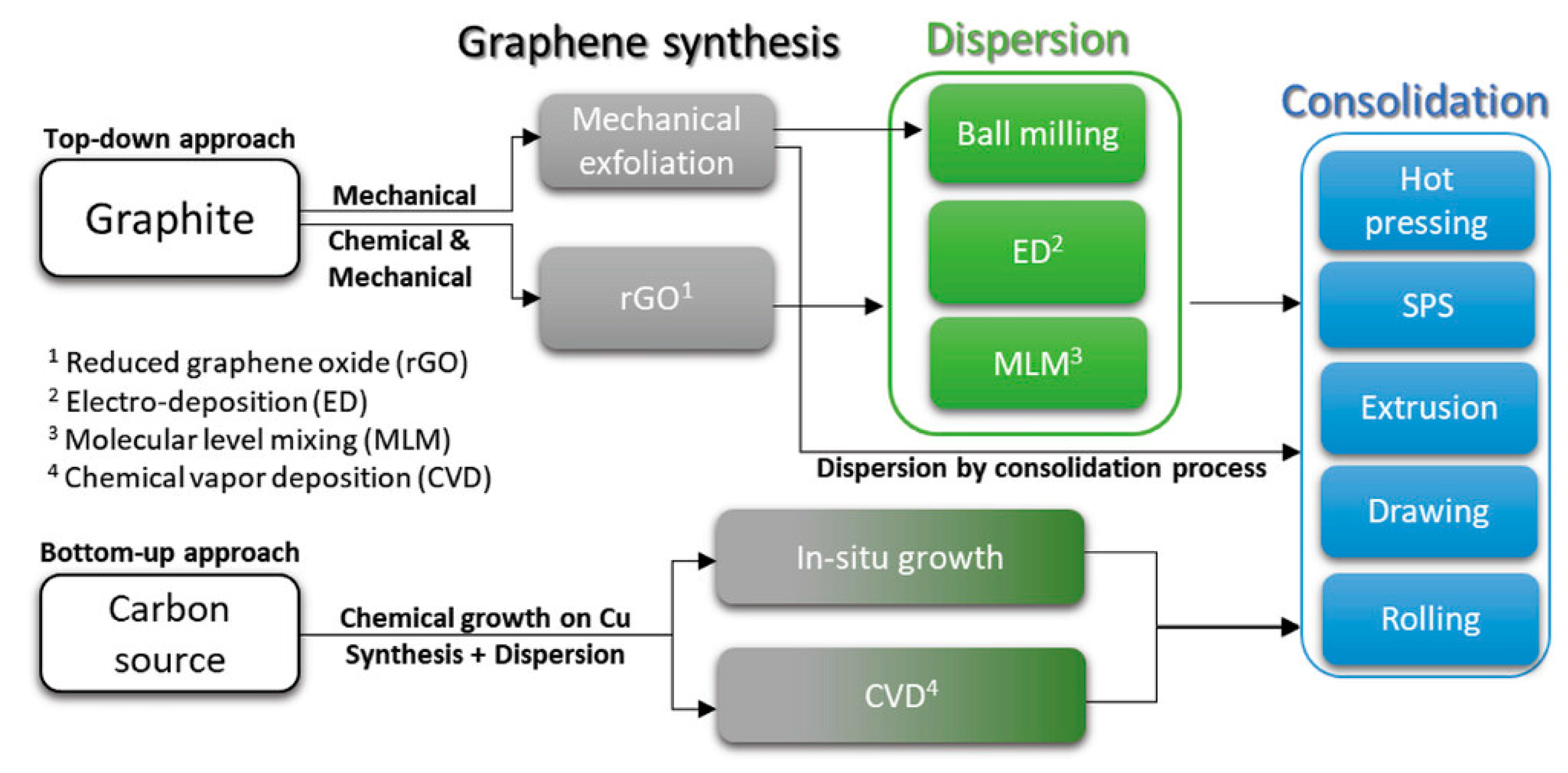
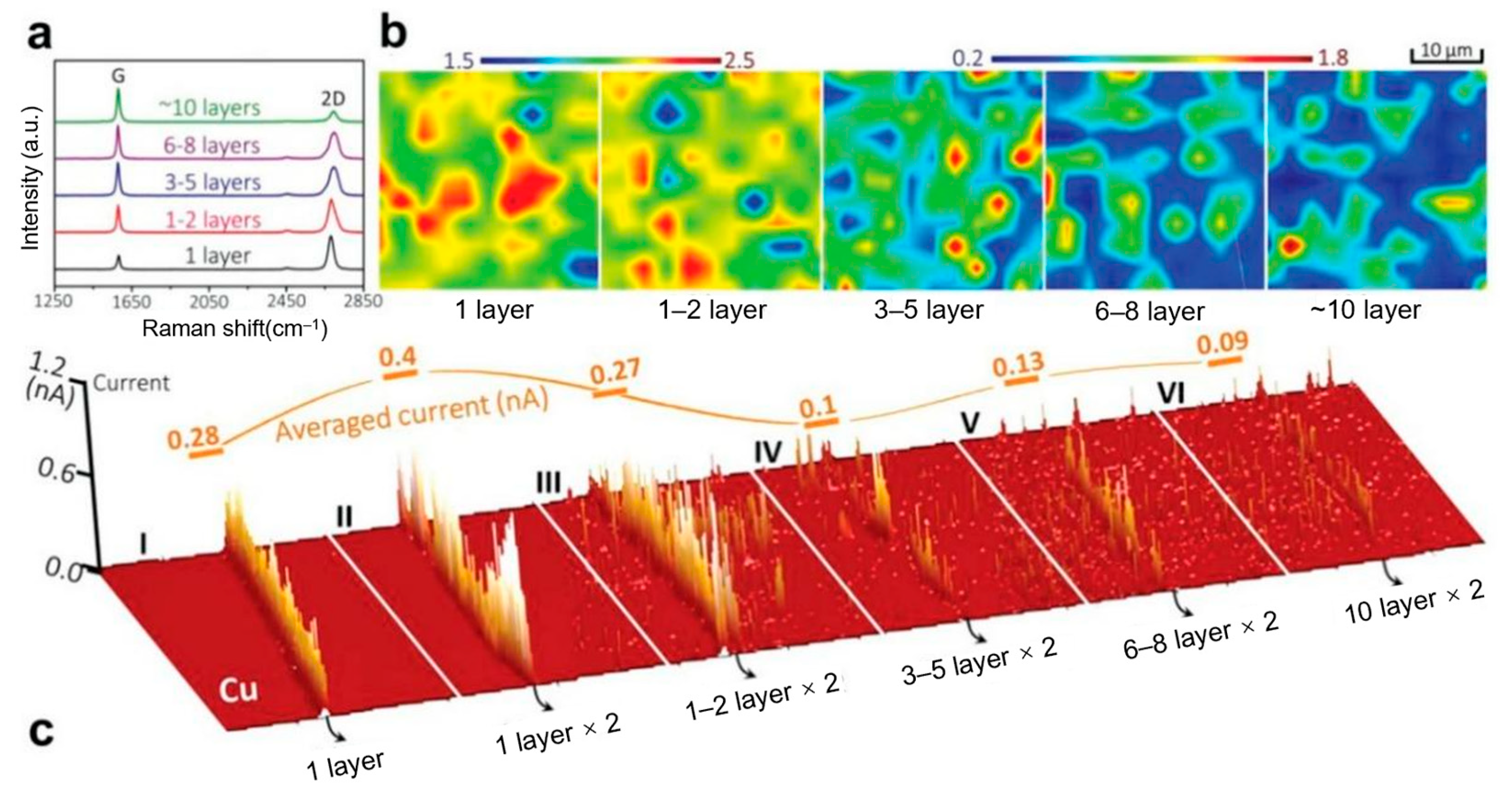
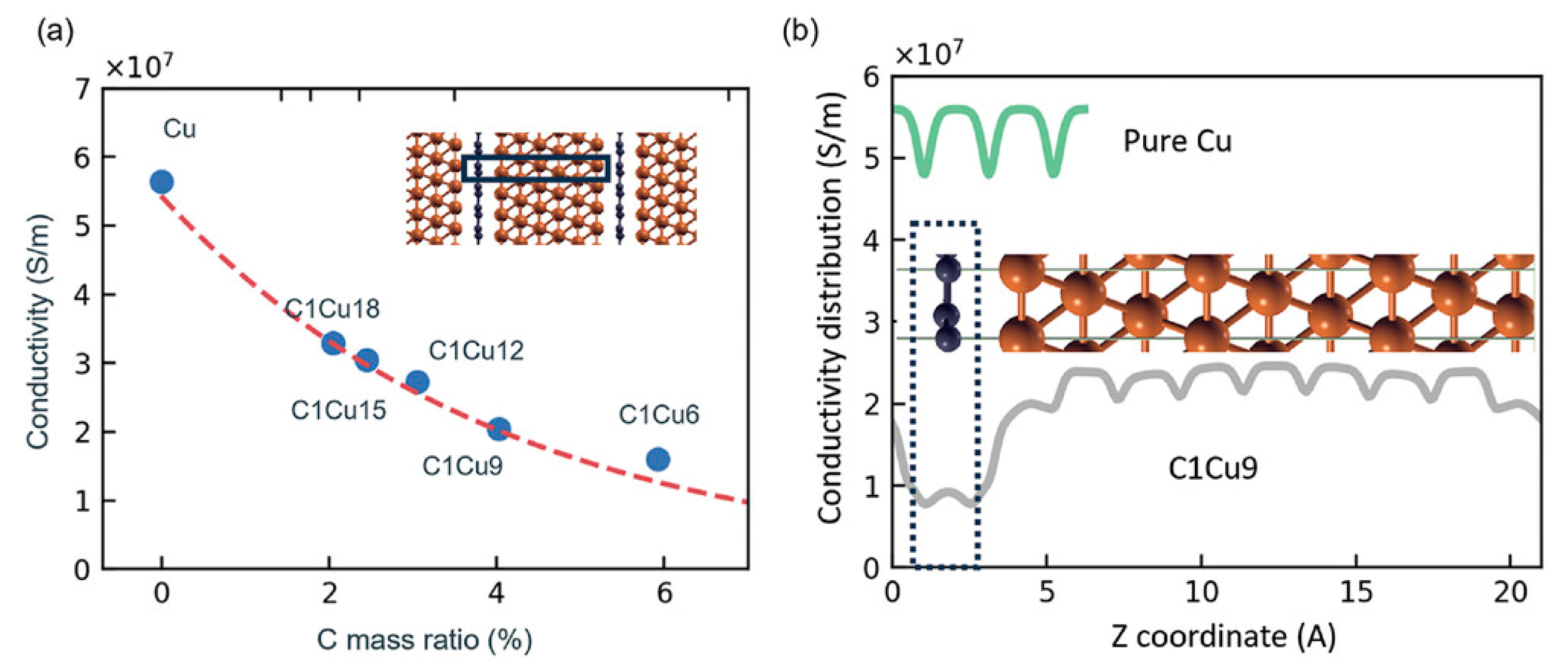
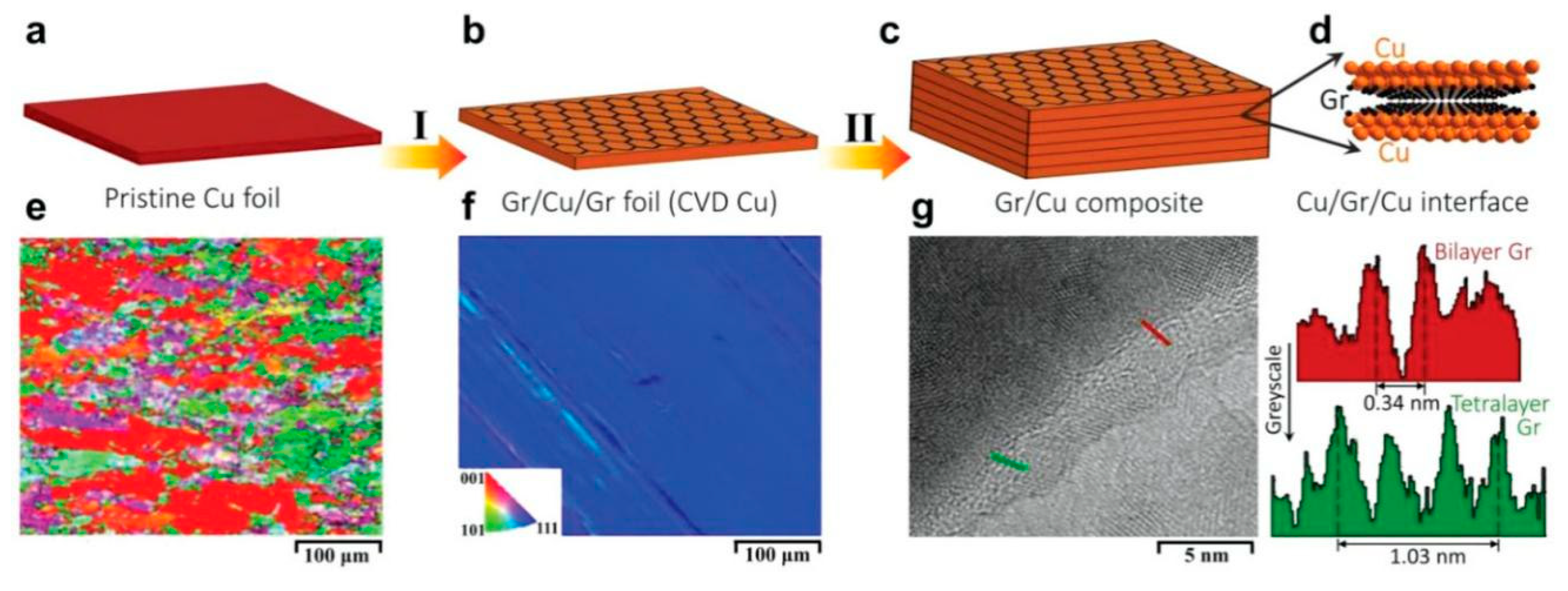
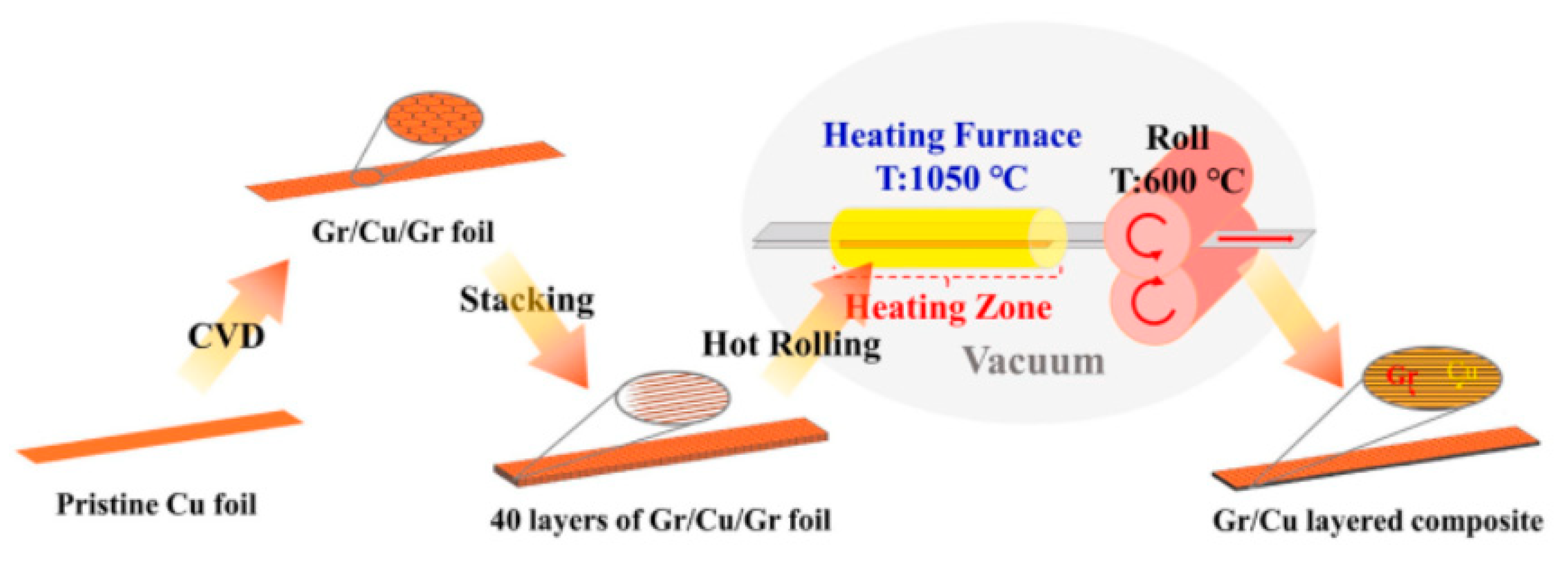
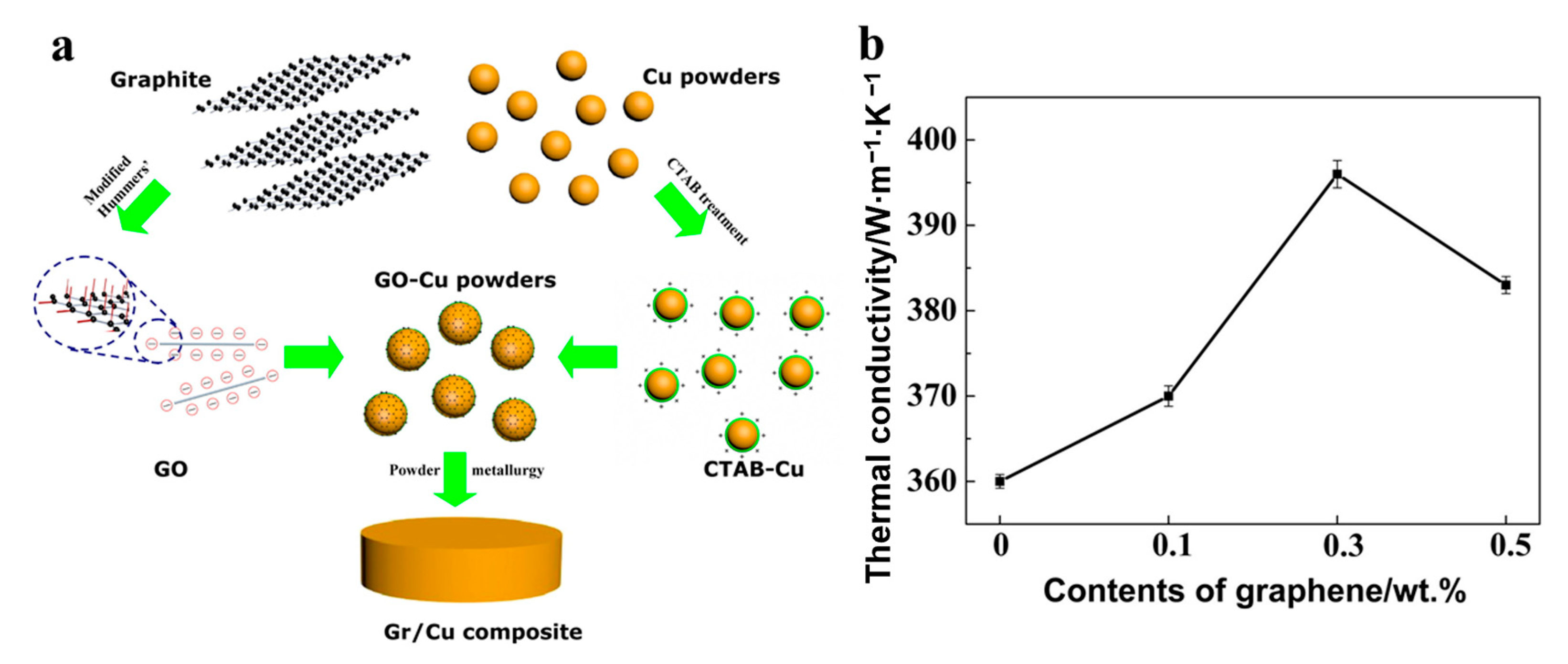

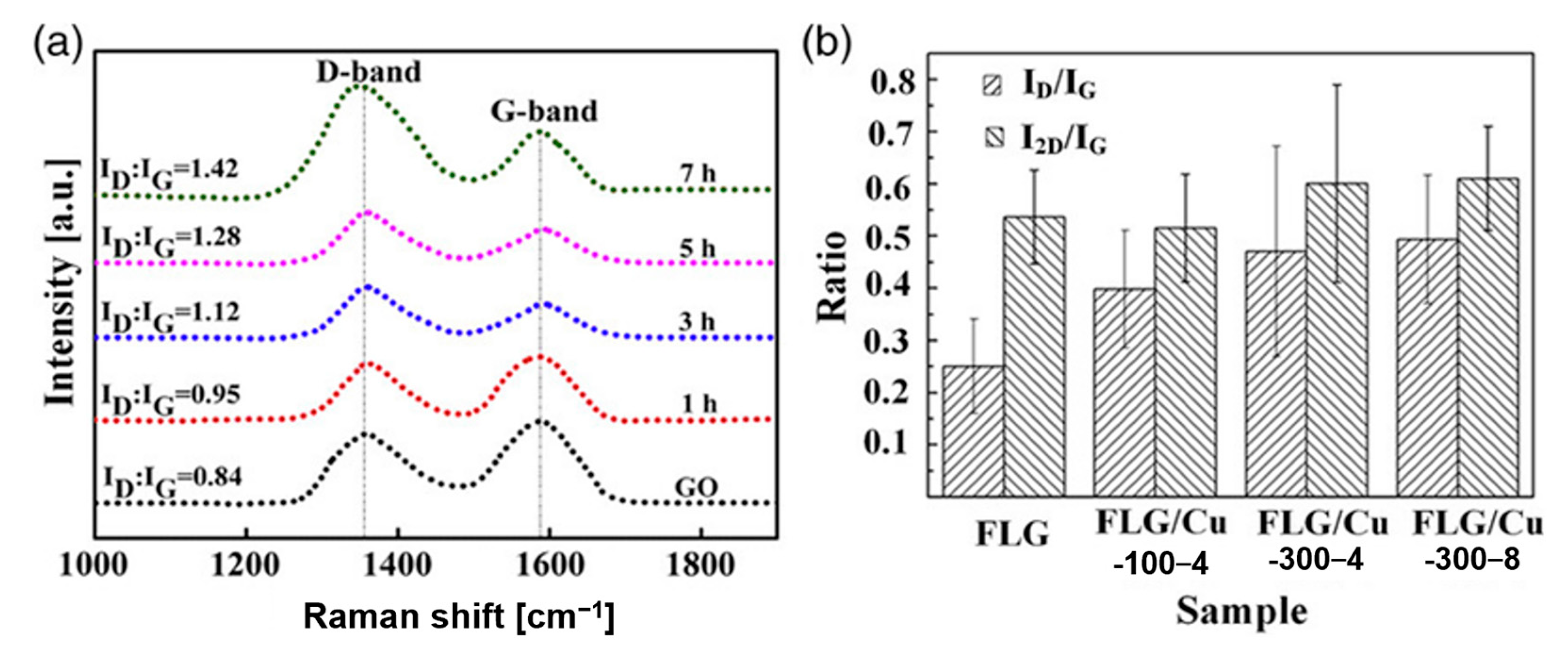
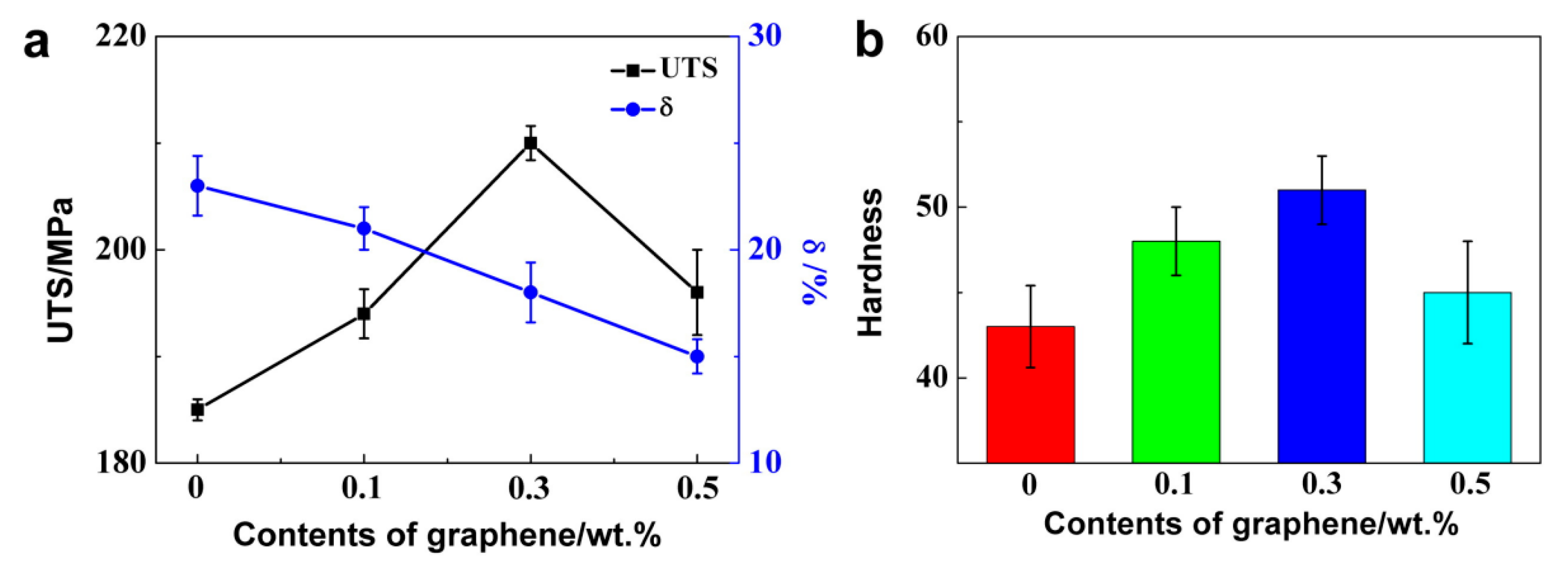
| Fabrication Method | Typical Graphene State | Key Merits | Typical Electrical Conductivity (%IACS) | Typical Tensile Strength (MPa) | Typical Thermal Conductivity (W·m⁻1·K⁻1) | Primary Challenges |
|---|---|---|---|---|---|---|
| Powder metallurgy | Nanosheets, potential agglomeration | Process simplicity, cost-effectiveness, near-net-shape capability | ~75–95 | ~250–400 | ~350–400 | Dispersion homogeneity, weak interfacial bonding |
| Molecular-level mixing | GO/rGO, abundant functional groups | Molecular-level dispersion, strong interfacial bonding | ~80–97 | ~300–500 | ~370–410 | Graphene quality (defects), residual oxygen groups |
| Electrochemical deposition | Nanosheets, potentially vertically aligned | Low-temperature processing, complex shapes/coatings | ~85–100 | ~250–450 | ~360–400 | Solution stability, limited deposit thickness |
| Chemical vapor deposition | In situ grown, large-area, low defects | Clean interface, superior graphene quality | ~95–117 | ~220–350 | ~400–500+ | High equipment cost, complex process, scalability |
| Electrical Conductivity | Preparation Method | Gr Content | Testing Method/Instrument | References |
|---|---|---|---|---|
| 84.2 %IACS | Liquid-phase mixing | 0.3 wt.% | Digital eddy current conductivity meter (Sigma 2008B, Xiamen Tianyan Instrument Co., Ltd., Xiamen, China) | [101] |
| 86.2 %IACS | RTA + roll | 0.12 wt.% | Eddy current method | [102] |
| 92.5 %IACS | MLM + SPS | 0.2 vol.% | Eddy current method | [103] |
| 94 %IACS | CVD + HP | – | Four-probe method | [104] |
| 95.7 %IACS | CVD + ball milling + SPS | 0.28 vol.% | Eddy current method | [63] |
| 95.9 %IACS | Powder metallurgy + HP | 0.5 wt.% | Digital conductivity meter (D60K-1201, Xiamen Xinbote Technology Co., Ltd., Xiamen, China) | [105] |
| 97.1 %IACS | Ball milling + RTA + HP + Hot rolling | 1.6 vol.% | Four-point probe instrument (Ecopia EPS-300, Ecopia, Republic of Korea) | [106] |
| 97.5 %IACS | Wet ball milling + HP | 0.6 wt.% | A conductivity meter (Sigmascope SMP10, Helmut Fischer GmbH, Sindelfingen, Germany) | [107] |
| Sintering: 98.05 %IACS; Cold drawing: 94.85 %IACS; Anneal: 97.28 %IACS | RTA+sintering/cold drawing/annealing | 0.021 wt.% | Digital eddy current conductivity meter (Sigma 2008B, Xiamen Tianyan Instrument Co., Ltd., Xiamen, China), high precision Casley current voltmeter, CMT6104 general purpose machine of MTS, MTS Systems (China) Co., Ltd., Shanghai, China | [64] |
| 100.5 %IACS | CVD + vacuum hot pressing, hot extrusion, and cold drawing | 0.08–0.09 vol.% | Eddy current conductivity method and four-probe conductivity method | [65] |
| 102 %IACS | CVD + shear extrusion | 25 ppm | Electrical properties (HAHPE) measurement system, Four-point probe instrument (Ecopia EPS-300, Ecopia, Republic of Korea) | [108] |
| 103.4 %IACS | RTA + HP + hot rolling | 0.387 vol.% | Eddy current conductivity meter (FQR-7501, Xiamen Xinsha Instrument Co., Ltd., Xiamen, China) | [61] |
| 103.65 ± 0.072 %IACS | CVD+hot extrusion | 0.0025 wt.% (250 ppm) | Standard four-point probe method according to ASTM B193 standard [109] | [46] |
| 110 %IACS | CVD + magnetron sputtering deposited Cu | <0.0008 vol.% | Four-probe method | [110] |
| 117 %IACS | CVD + HP | 0.008 vol.% | Four-probe method | [80] |
| CNTs Contents (vol.%) | ||||||||
|---|---|---|---|---|---|---|---|---|
| 0 | 0.5 | 1.0 | 1.5 | 2.0 | 3.0 | 5.0 | 10.0 | |
| Thermal diffusivity (cm2·s−1) | 1.03369 | 1.05068 | 1.06419 | 1.07329 | 1.05610 | 1.06571 | 1.04416 | 1.04468 |
| Specific heat (J·g−1·K−1) | 0.38400 | 0.38436 | 0.38472 | 0.38509 | 0.38546 | 0.38620 | 0.38773 | 0.39177 |
| Thermal conductivity (W·m−1·K−1) | 348.7 | 353.1 | 359.2 | 357.2 | 351.3 | 354.2 | 340.5 | 335.2 |
| Gr Source | Material | Preparation Method | Thermal Conductivity (W·m−1·K−1) | References |
|---|---|---|---|---|
| RGO | PTG/Cu-CuxO + Cu + 0.1wt%PTG | sintered | 168.5 | [131] |
| UTG + Cu + 0.1wt%UTG | 64.8 | |||
| Pure Cu | charge adsorption + thermal reduction + HP sintering | 375 | [132] | |
| 0.3wt%RGO + Cu | 405 | |||
| 0.6wt%RGO + Cu | 413 | |||
| 0.9wt%RGO + Cu | 364 | |||
| FGr/Cu | pulsed-current co-electrodeposition | 497 | [133] | |
| Gr | 5%GNP/Cu | electroless plating method | 298.7 | [134] |
| 20%GNP/Cu | 221.4 | |||
| GP/Cu | vacuum hot pressing | 968 | [26] |
| Gr Source | Material | Preparation Method | Yield Strength (MPa) | Maximum Strength (MPa) | Elongation (%) | References |
|---|---|---|---|---|---|---|
| RGO | 2.5 vol% RGO/Cu | MLM + SPS | 284 | [55] | ||
| Pure Cu | MLM + self-assemble + SPS | 73.9 | 294 | 7.2 | [153] | |
| 2.5 vol% RGO/Cu | 82.2 | 450 | 7.5 | |||
| 2.5 vol%CNT-RGO/Cu | 107.4 | 601 | 11.8 | |||
| 0.3 wt%RGO + Cu | charge adsorption + thermal reduction + HP sintering | 90.8 | 191.3 | 14.4 | [132] | |
| 0.6 wt%RGO + Cu | 188 | 206.3 | 21 | |||
| 0.9 wt%RGO + Cu | 158 | 226.7 | 12 | |||
| Pure Cu | 396 | 422 | 1.66 | |||
| Gr | Gr/Cu-50 | vacuum HP sintering | 474 | 516 | 0.80 | [64] |
| Gr/Cu-80 | 505 | 549 | 0.96 | |||
| 1.6 g·L⁻1Gr/Cu | pulse electrodeposition | 156 | 274 | 18.7 | [154] | |
| Gr/Cu | accumulative roll-compositing | 281 | 686 | 16.5 | [155] | |
| 0.6 wt%Gr/Cu | wet ball milling + HP | 65.2 | 290.47 | 49.3 | [107] |
Disclaimer/Publisher’s Note: The statements, opinions and data contained in all publications are solely those of the individual author(s) and contributor(s) and not of MDPI and/or the editor(s). MDPI and/or the editor(s) disclaim responsibility for any injury to people or property resulting from any ideas, methods, instructions or products referred to in the content. |
© 2025 by the authors. Licensee MDPI, Basel, Switzerland. This article is an open access article distributed under the terms and conditions of the Creative Commons Attribution (CC BY) license (https://creativecommons.org/licenses/by/4.0/).
Share and Cite
Liu, W.; Zhao, X.; Li, H.; Ding, Y. Research Progress on the Preparation and Properties of Graphene–Copper Composites. Metals 2025, 15, 1117. https://doi.org/10.3390/met15101117
Liu W, Zhao X, Li H, Ding Y. Research Progress on the Preparation and Properties of Graphene–Copper Composites. Metals. 2025; 15(10):1117. https://doi.org/10.3390/met15101117
Chicago/Turabian StyleLiu, Wenjie, Xingyu Zhao, Hongliang Li, and Yi Ding. 2025. "Research Progress on the Preparation and Properties of Graphene–Copper Composites" Metals 15, no. 10: 1117. https://doi.org/10.3390/met15101117
APA StyleLiu, W., Zhao, X., Li, H., & Ding, Y. (2025). Research Progress on the Preparation and Properties of Graphene–Copper Composites. Metals, 15(10), 1117. https://doi.org/10.3390/met15101117





